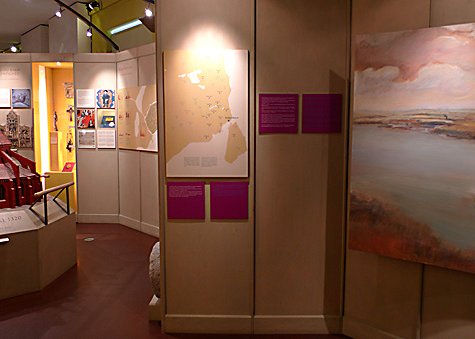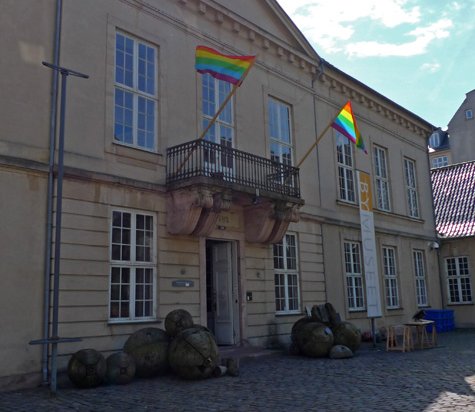| “The present is not enough.”
– José Esteban Muñoz, Cruising Utopia [1]
In the summer of 2009 Copenhagen was crowned LGBT capital of Europe. Or, at least, so it seemed. For an extended week, from July 25 to August 2, Copenhagen hosted World Outgames 2009, “an international sports, cultural and human rights event highlighting and celebrating the vitality in the global LGBT environment.”[2] Thousands of participants and tourists filled the streets of Copenhagen during these days, in a city literally draped in rainbow flags. For a researcher on gender and sexual political art and activism this was obviously a good time to be in town. Not only were lots of LGBT events, actions, and exhibitions on, but the visitors from all over the world also changed the face and sound of the city to the better. Copenhagen was quite sexy this week, no doubt. |  | ![[1] José Esteban Muñoz, Cruising](Resources/item1a3a1b1ab.gif)
| 
|  |  | Out of the many events happening, I was especially eager to see the exhibition at the Copenhagen City Museum included in the Outgames cultural program, Som jeg er: homo/bi/trans i Kbh – As I Am: LGBT in CPH. This was the first major exhibition about LGBT life to be presented in any Danish historical museum, and I must admit that I had quite high expectations to the show. This was not only due to the fact that the exhibition was well funded by the municipality, but also because of the ambitious curators who had created quite some stir in advance of the show. In October 2008 the City Museum and Outgames arranged a seminar in relation to As I Am entitled, “That which is not visible, does not exist. That which does not exist does not have any rights.”[3] The seminar included a number of museums directors and curators from major public institutions in Copenhagen who had been invited to discuss why LGBT perspectives and histories are absent from their collections. Suffice to say it was a rather sad seminar. The museum directors delivered a series of well-known excuses. The curator of the Medical Museion, for instance, explained how she did not think the museum had anything relevant in their archives. Others said the same. They all, of course, wanted to include LGBT histories in their museums, but they did not have any stories to tell. While LGBT history seemed to be lost, so was the imagination and curiosity of the museum directors. |  | ![[3] My translation of the](Resources/item1a3a1b1.gif)
| 
|  |  | In contrast, the curators of the As I Am exhibition had a different perspective and will to change: Inger Wiene, the inspector at the City Museum, and anthropologist Jens Pedersen were eager to create a different exhibition, based on a critical perspective on how alternative histories could be told. At the seminar they talked about the demanding archival work they had undertaken and their upcoming plans of interviewing the local LBGT community, whose opinions and stories they wanted to include in the show.

I was curious to see the result of the curators’ vision for As I Am, and went for a visit shortly after the opening. The museum’s façade was decorated with rainbow flags on golden flagpoles, but once inside it was quite difficult to know where the exhibition started. It turned out that it took place on both floors of the museum – with smaller interventions in the main collection, and a large exhibition in the banquet hall on the museum’s first floor. |  | | 
|  |  | 
|  | | 
|  |  | After wandering for quite some time through the rooms of the permanent exhibition on the story of Copenhagen, I finally found some evidence of As I Am: Small purple placards with text, glued on to the walls and window displays. The first pieces I found were placards with quotes on homosexuality from the Bible. The quotes were presented without any explanation or context, and while obviously functioning as a general reminder of the long tradition of Christian homonegativism, it was difficult to understand what they were meant to tell us about LGBT life in Copenhagen in the past. The placement of the placards around an old map of Zealand didn’t make the intention any clearer. Fortunately, some of the other texts were more motivated and informative, especially the few placards with fascinating stories of “sodomites” and “criminals” of the past. Mainly based on prison reports, one of these placards included a brief account of Gotfried Jacob Eichstedt – a tailor apprentice who was arrested in 1784 after his “real” name was revealed to be Maria Stokkenbech. Unfortunately, these stories were not integrated in the permanent displays, and quite a few of them appeared to be early drafts rather than thoroughly worked-out texts. The stories of Copenhageners of the past raised the difficult questions of names, identities, and labels in history writing. As the exhibition was said to cover LBGT in CPH, one started to wonder how to understand the identity categories in this context. For instance, was the tailor apprentice Gotfried Jacob Eichstedt to be seen as a trans man? transvestite? or (butch) lesbian? Given that a term such as “transsexuality” is a fairly recent construction, dating back to the last two decades of the 19th century – and the current meanings of the LGB categories are even younger – categorizing historically on the basis of these modern terms is obviously problematic. Of course, the fact that these terms did not exist does not mean that homo- and bisexual acts did not happen, or that trans people did not exist – but how are we to categorize such actions of the past in the present? Reflections on historical identification and anachronism were absent in this part of the show, underlining the presentist attitude suggested by the exhibition’s title As I Am. But it would have been interesting to know how the problems and challenges of the politics of identity, central to the archival logic of LGBT history, had influenced the curators’ selection on which subjects and histories to include in the exhibition. In spite of the few captivating stories, it was difficult not to be disappointed by the fact that these placards were the only interventions in the museum’s permanent exhibition. I can hardly think of a more traditional way of interfering in a major collection than adding small notes with extra LGBT information. The few placards left the structure of the exhibition untouched, and the intervention did nothing to challenge the heteronormative construction of the city’s history represented in the museum – centered, as it is, on family, church, (male) workers, (male) army officers, etc. As I Am could have disrupted this narrative by for instance highlighting the exclusionary logic behind these straight stories, or by visualizing the absence of alternative lives and bodies in the window displays of the City Museum. Instead the placards seemed to want to “repair” the current heteronormative story by including some extra information. The result of this restoration process seemed anything but successful. |  | | 
|  |  | 
Those of us working with LGBT and queer histories are familiar with the difficult archival politics of state museums and archives when it comes to alternative storytelling. Many of us have realized, as historian Peter Hegarty poignantly puts it, how “the recovery of gay and lesbian pasts is impeded by the lack of a coherent lesbian and gay archive, the deliberate destruction of personal letters, and the withholding of access to archives for gay and lesbian scholars.”[4] There are endless stories of archives lost or destroyed due to historical or contemporary homophobia, and researchers on gender and sexuality have often met fierce resistance. When not destroyed, material on non-normative sexuality has also been excluded from official archives on a “moral” basis, related to the fact that homosexuality and other “perversions” have been criminalized and/or pathologized until fairly recently in the West. In institutional archives, traces of LGBT people of the past are usually only to be found in the registers of the criminal and sick.[5] While the curators of As I Am used some of these “negative” presences in the archives of criminals to tell the short stories of non-normative lives in Copenhagen in the past, the exhibition did not reflect upon these important archival and historiographical issues. This despite the fact that the problem of a seemingly “empty” archive was one of the reasons why this exhibition was necessary in the first place. In my opinion this represented a loss of opportunity, as the heteronormative structure of archives and history production would be an important and relevant theme to communicate to the visiting public, and not only a few notes with “facts” of LGBT life in Copenhagen of the past. |  | ![[4] Peter Hegarty, “Harry Stack](Resources/item1a3a1b1a1b.gif)
| 
|  |  | 
|  |  |
|





